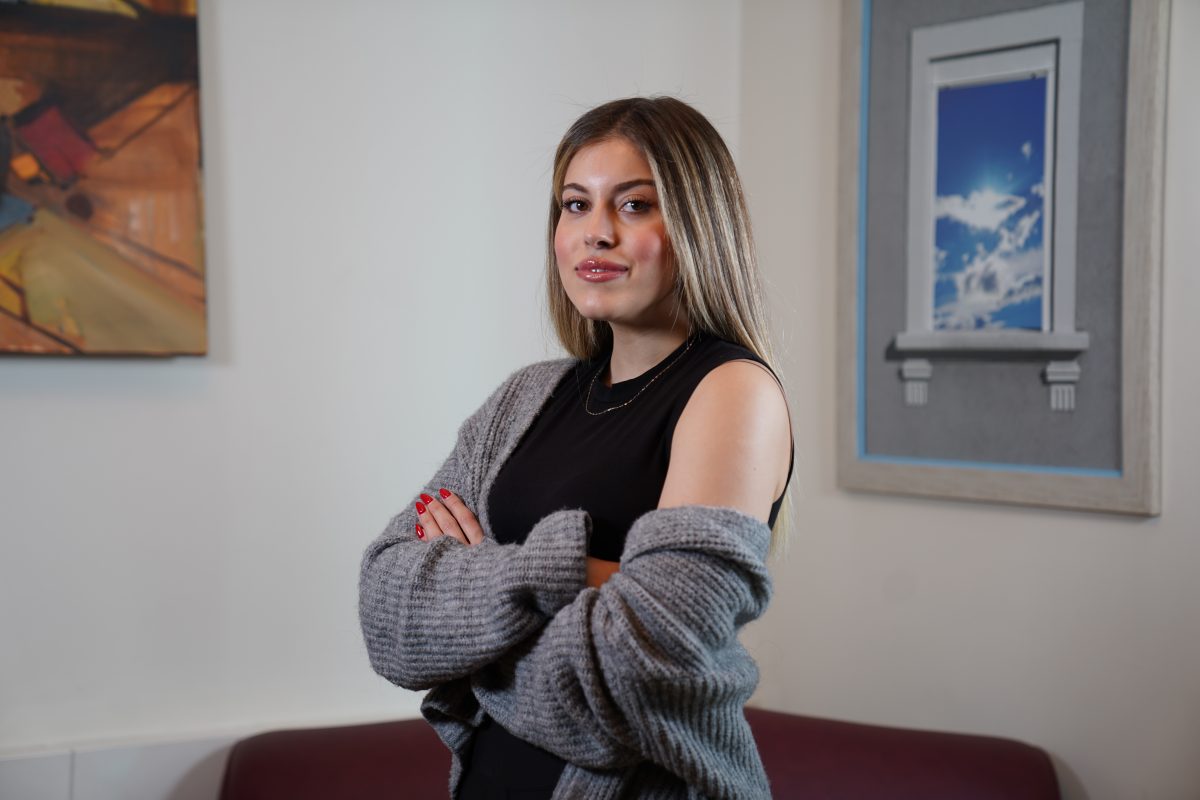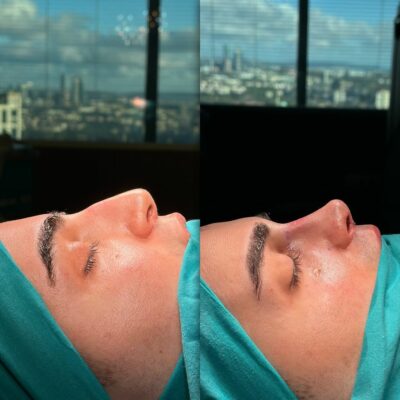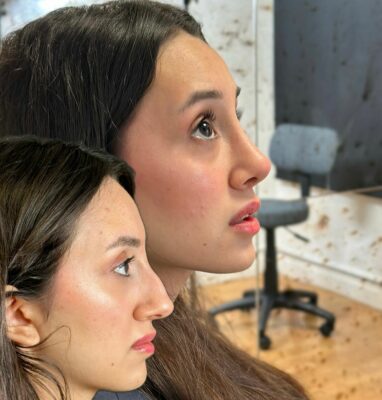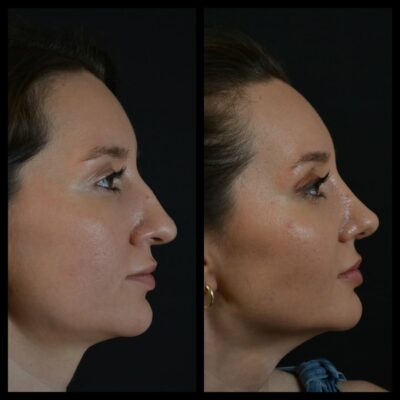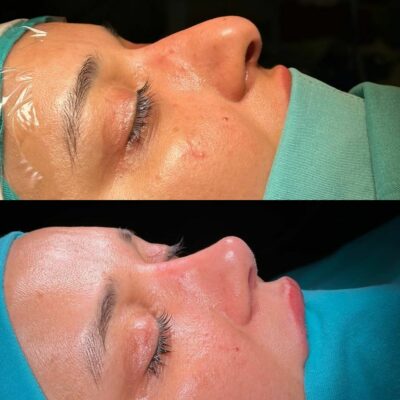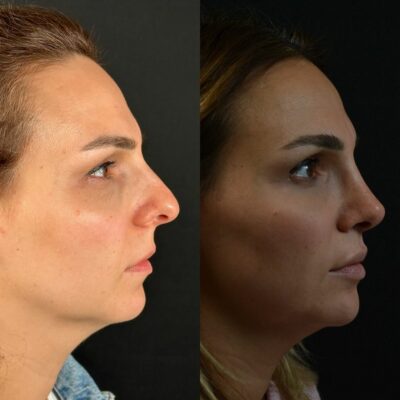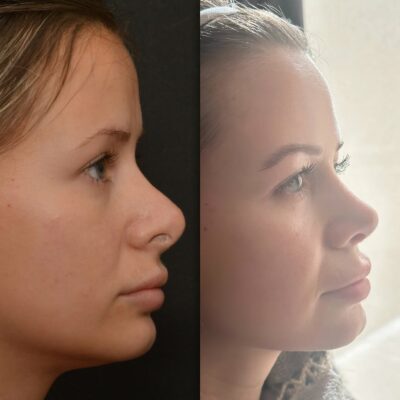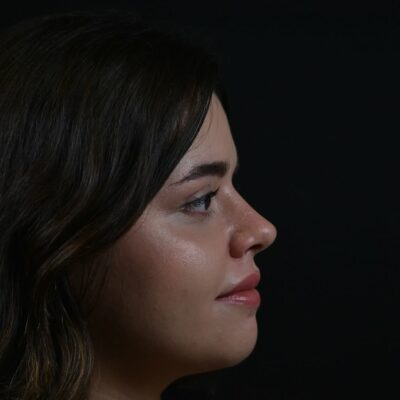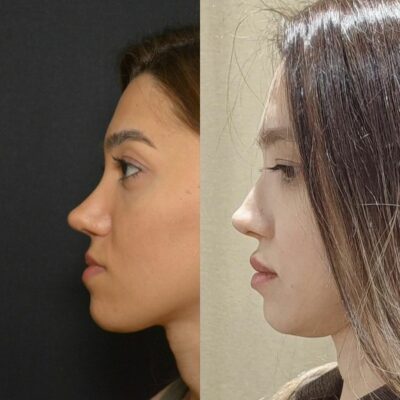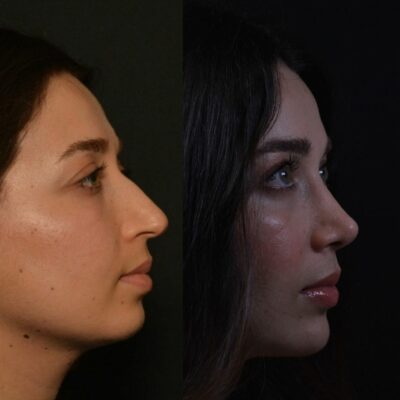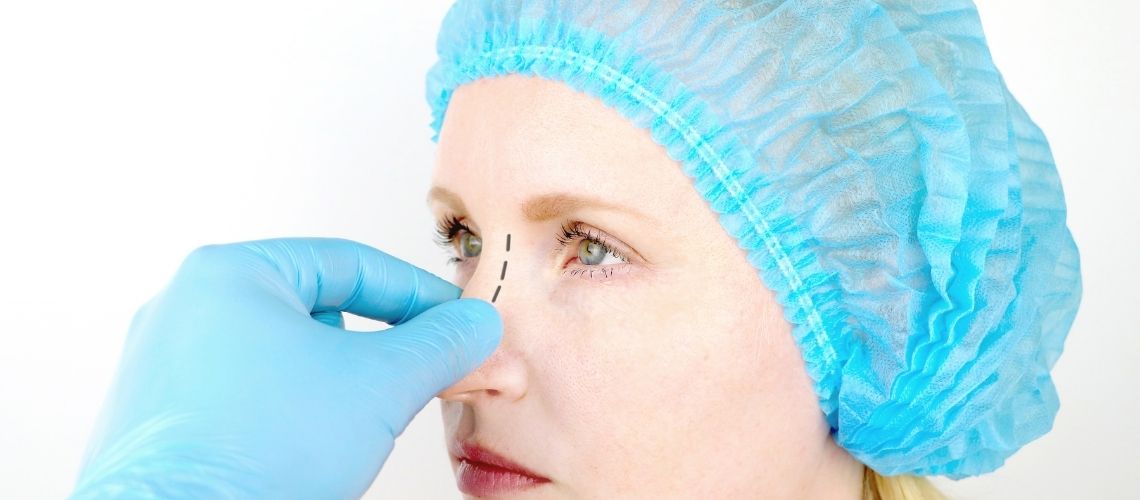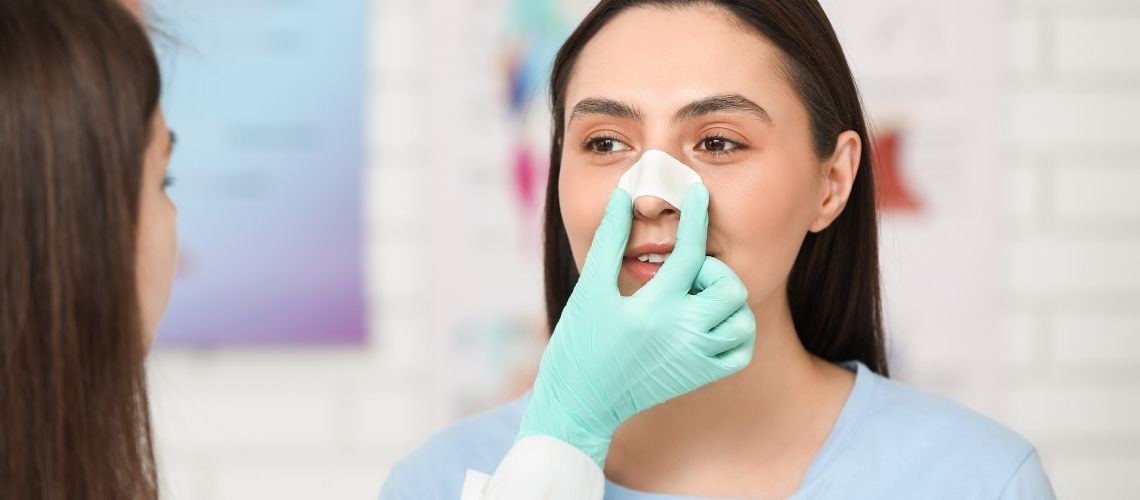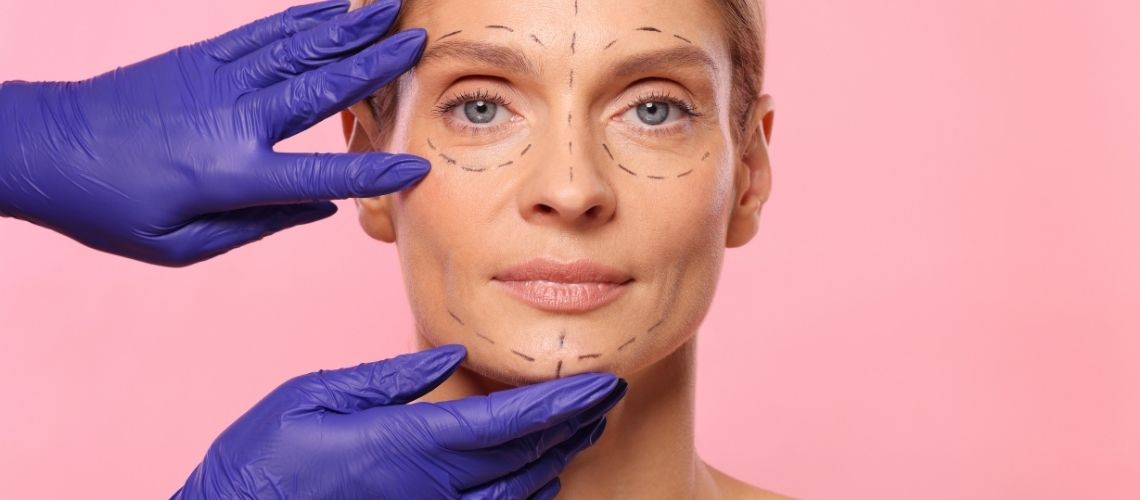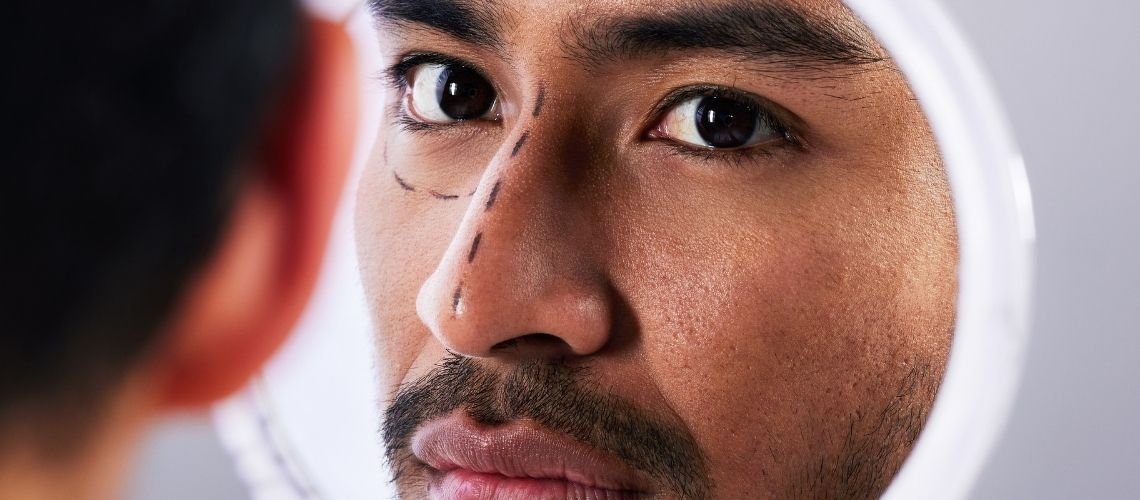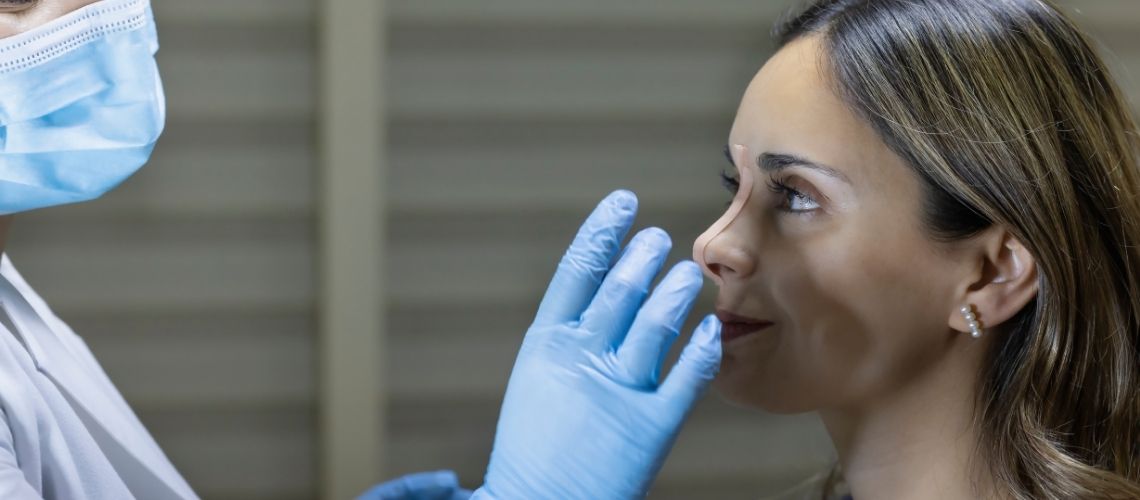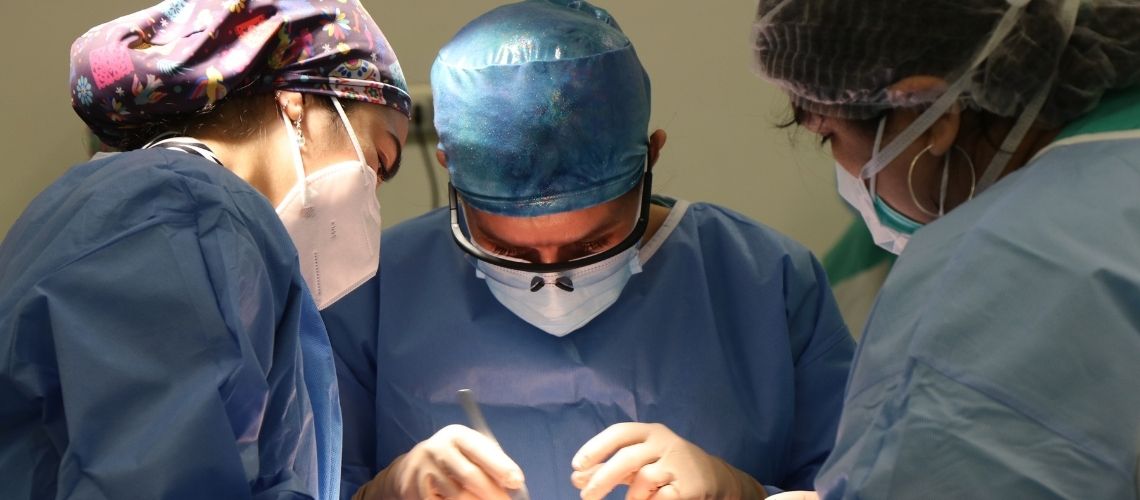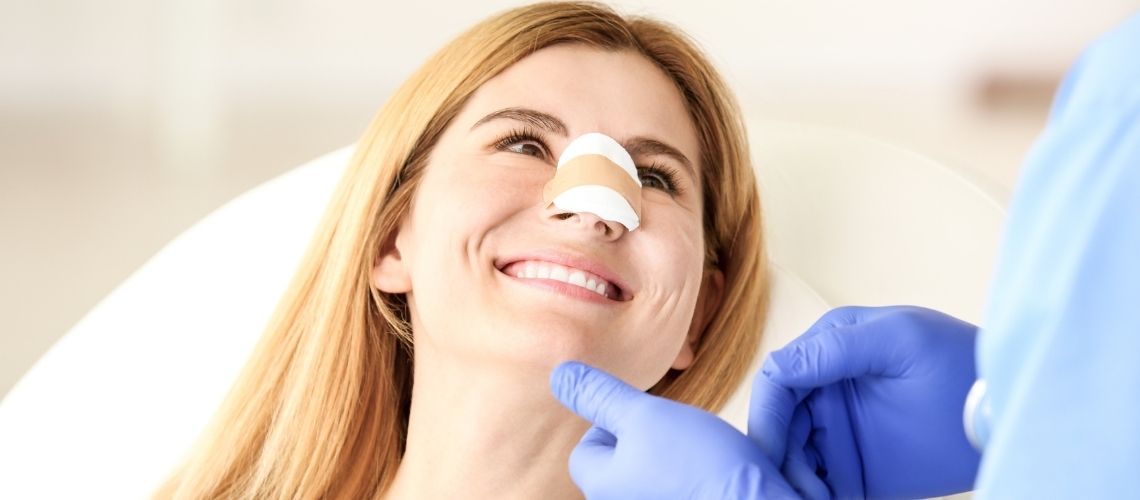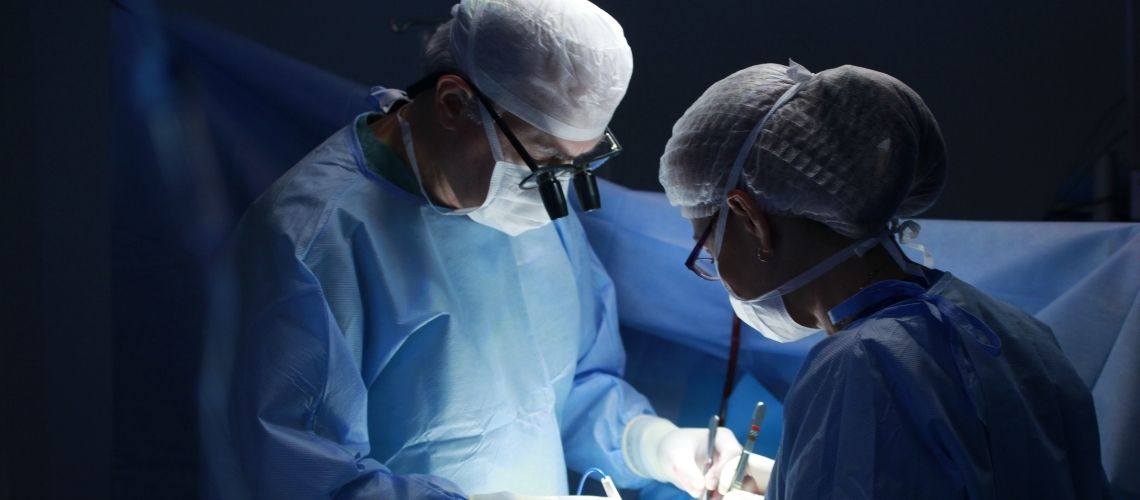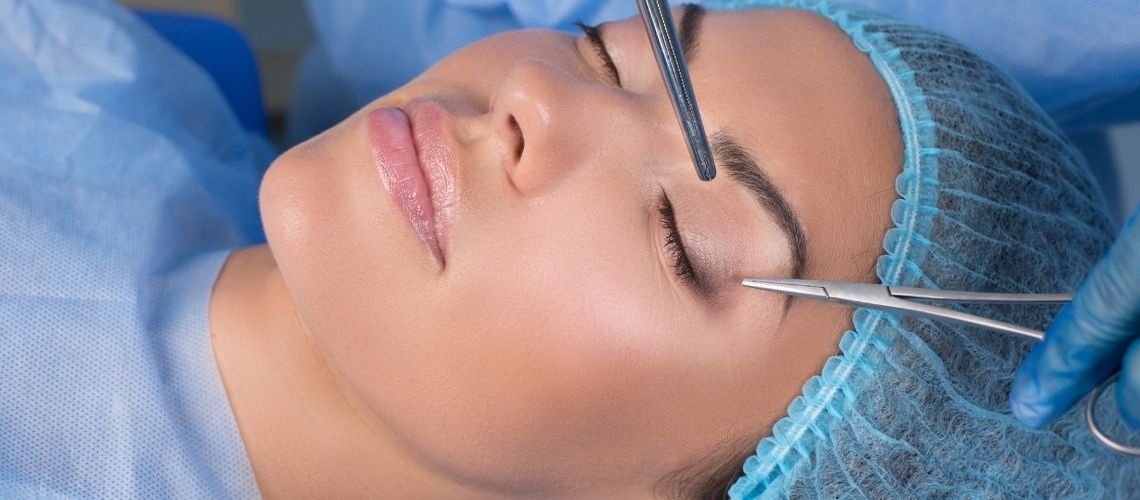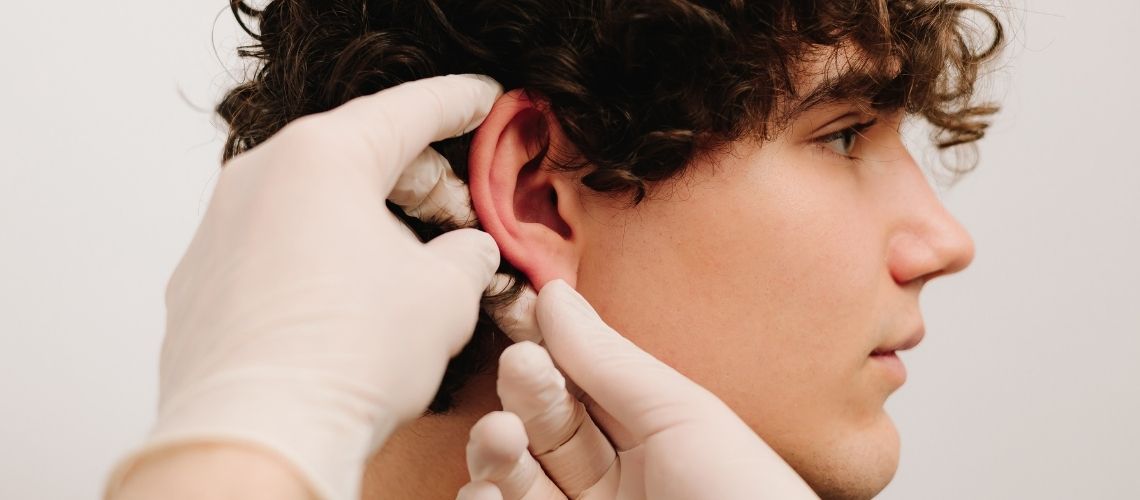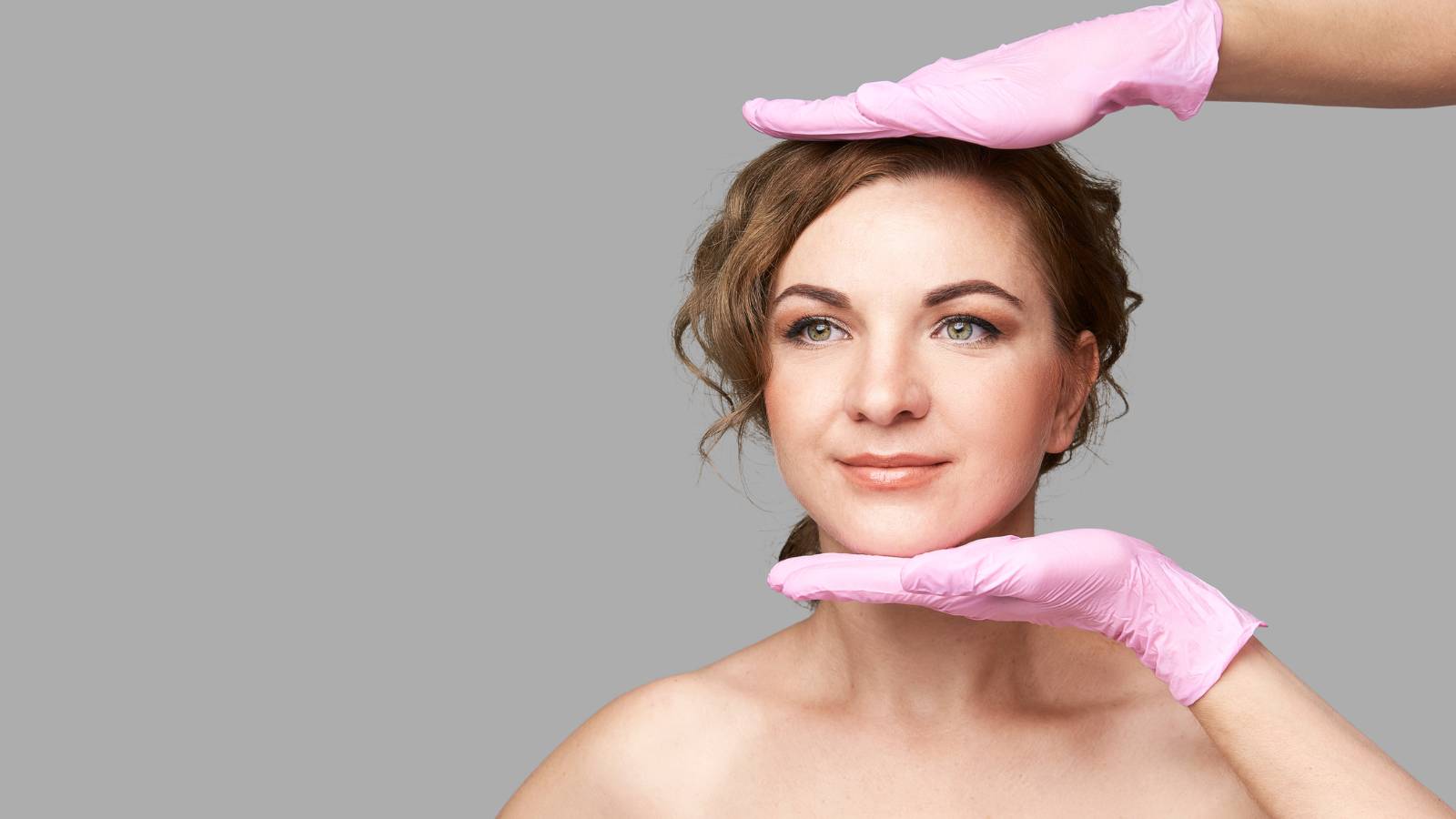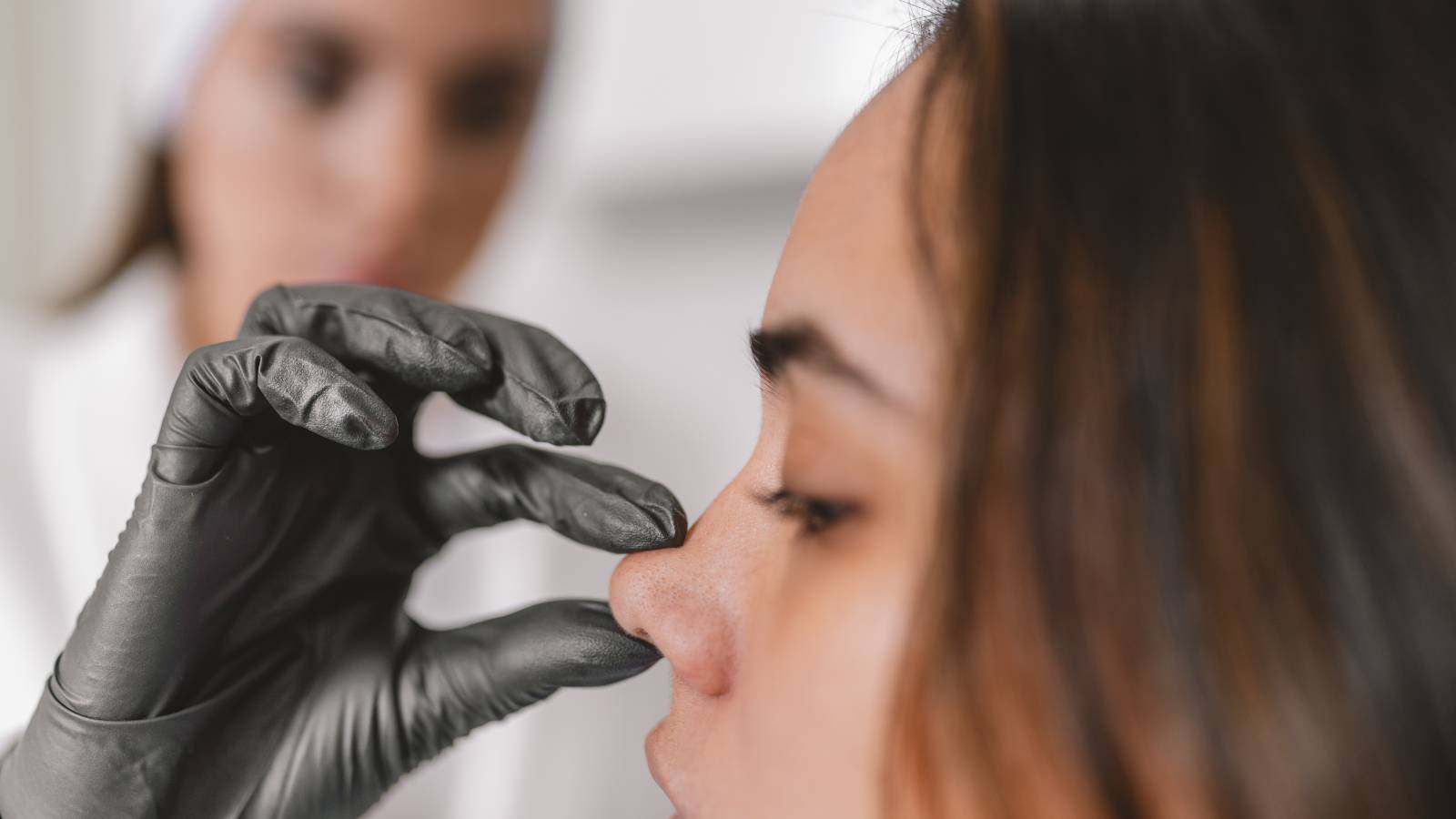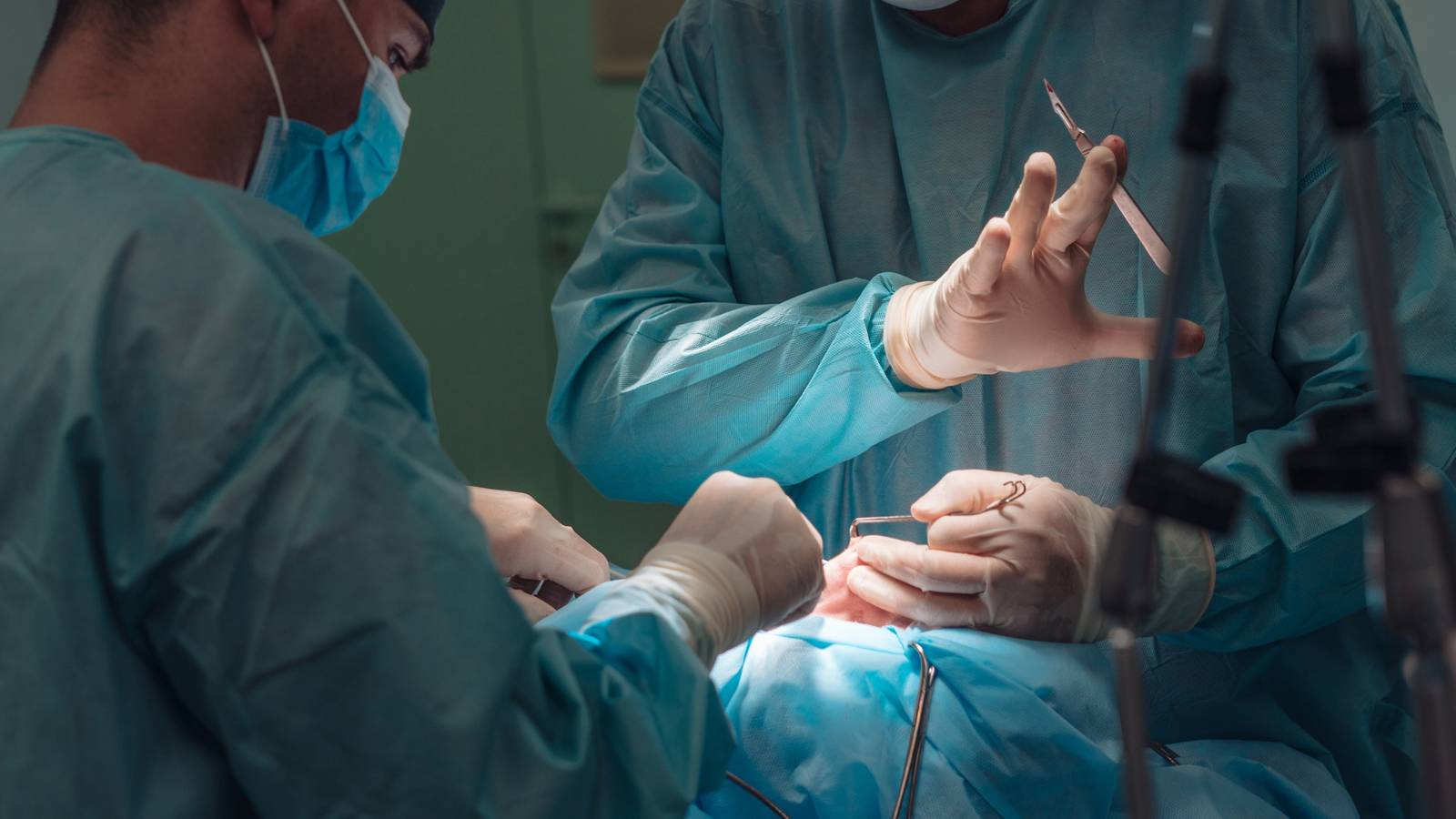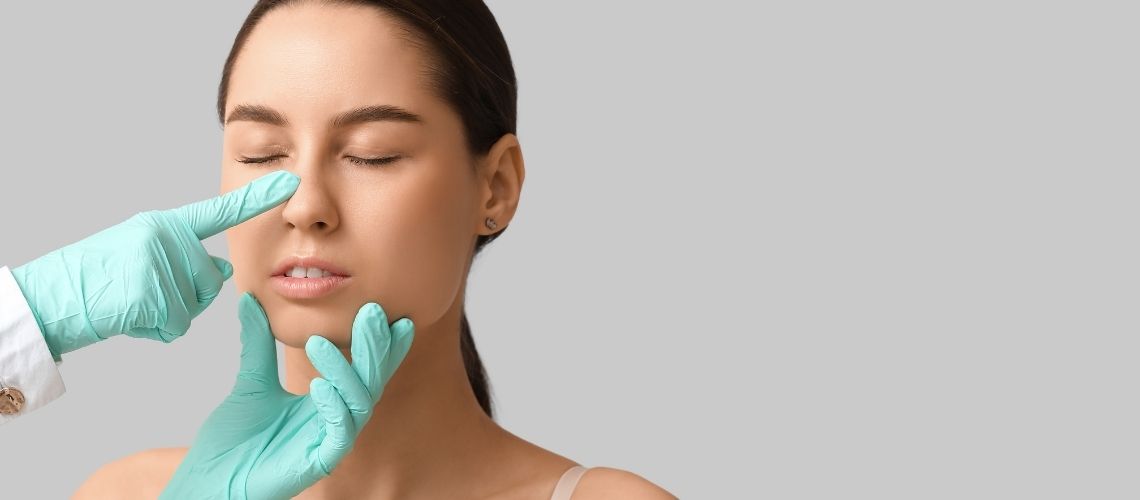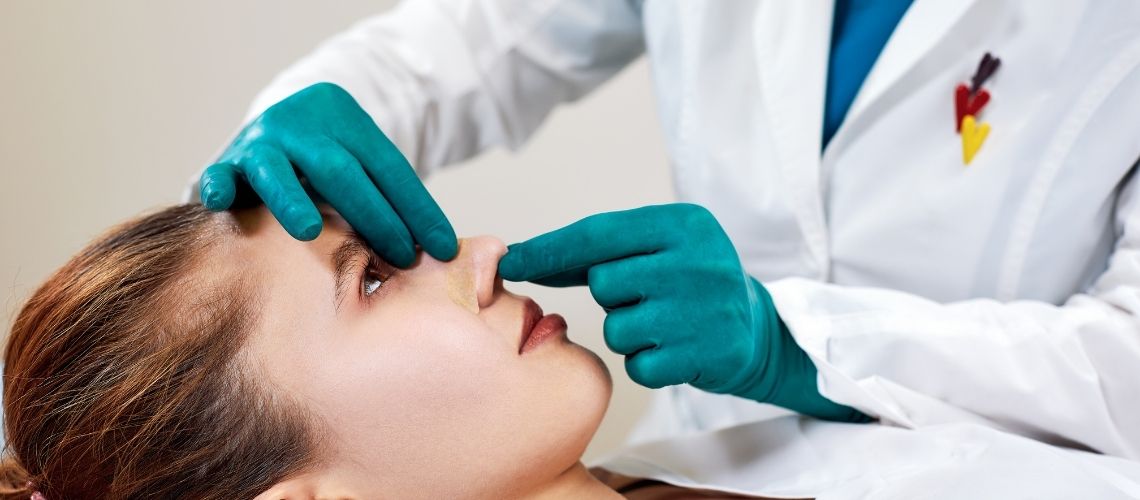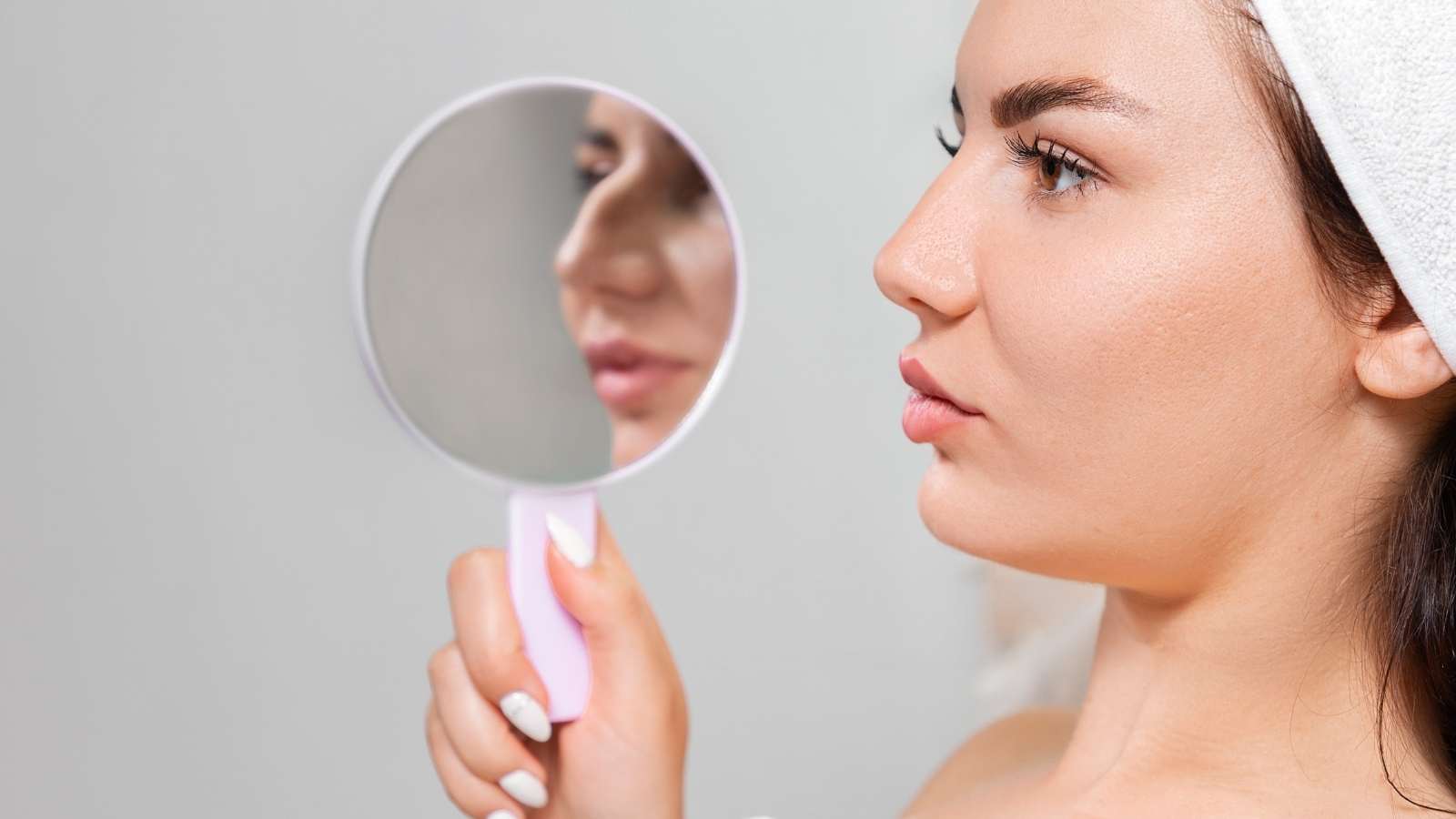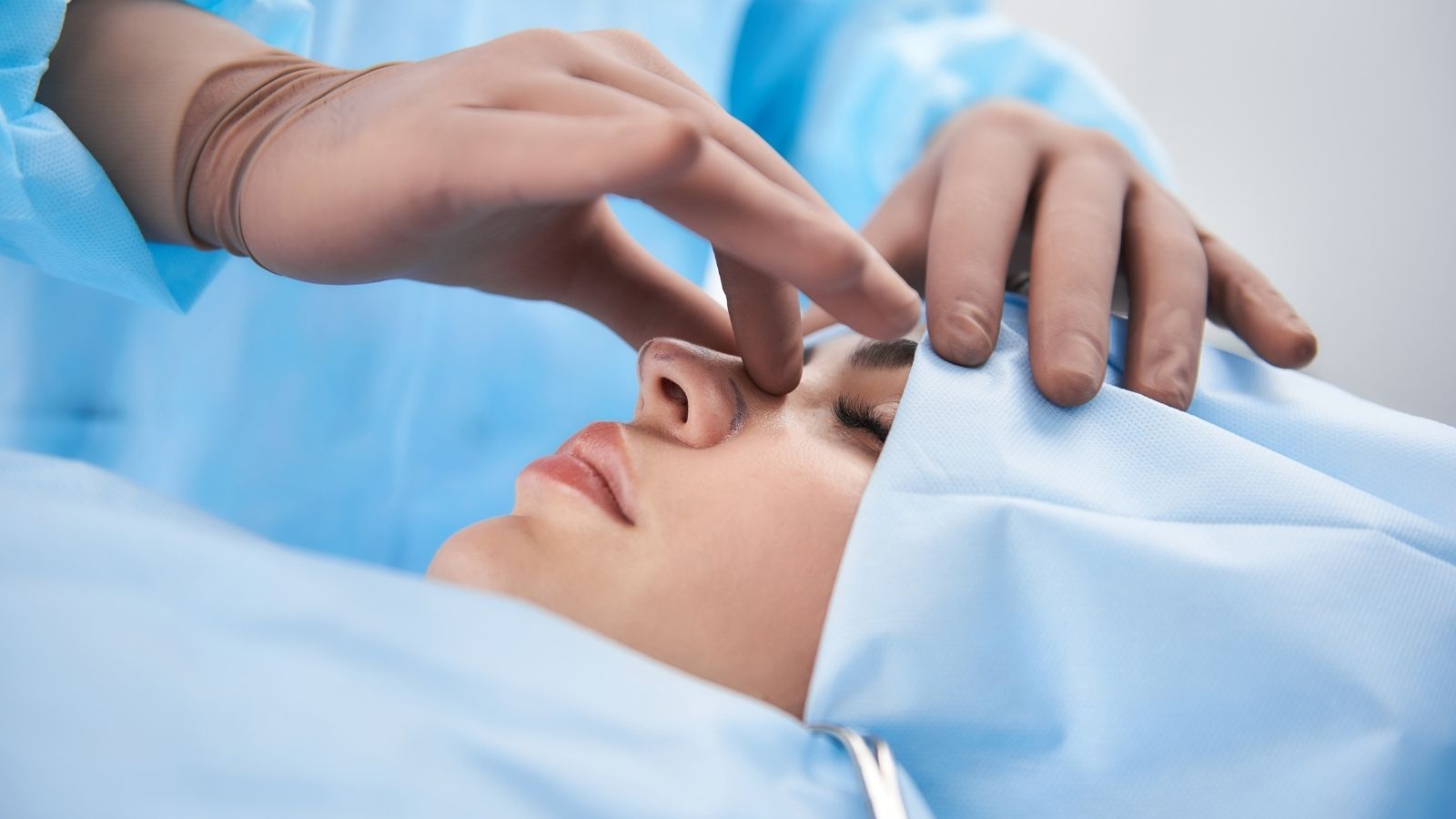
Septorhinoplasty in Turkey
Combine cosmetic enhancements with functional improvements through Septorhinoplasty in Turkey at our clinic. Dr. Alev Camcıoğlu expertly corrects deviated septums while enhancing the nose’s external appearance. This dual-purpose procedure ensures better breathing and a boost in self-confidence with a beautifully shaped nose.
Cost of Septorhinoplasty in Istanbul, Turkey ranges between €5,000– €7,000 in 2025 depending on hospital, package, and anatomy of your nose. Check our prices, before & after photos, and patient results from the USA, UK, Canada, Australia, and the rest of the world.
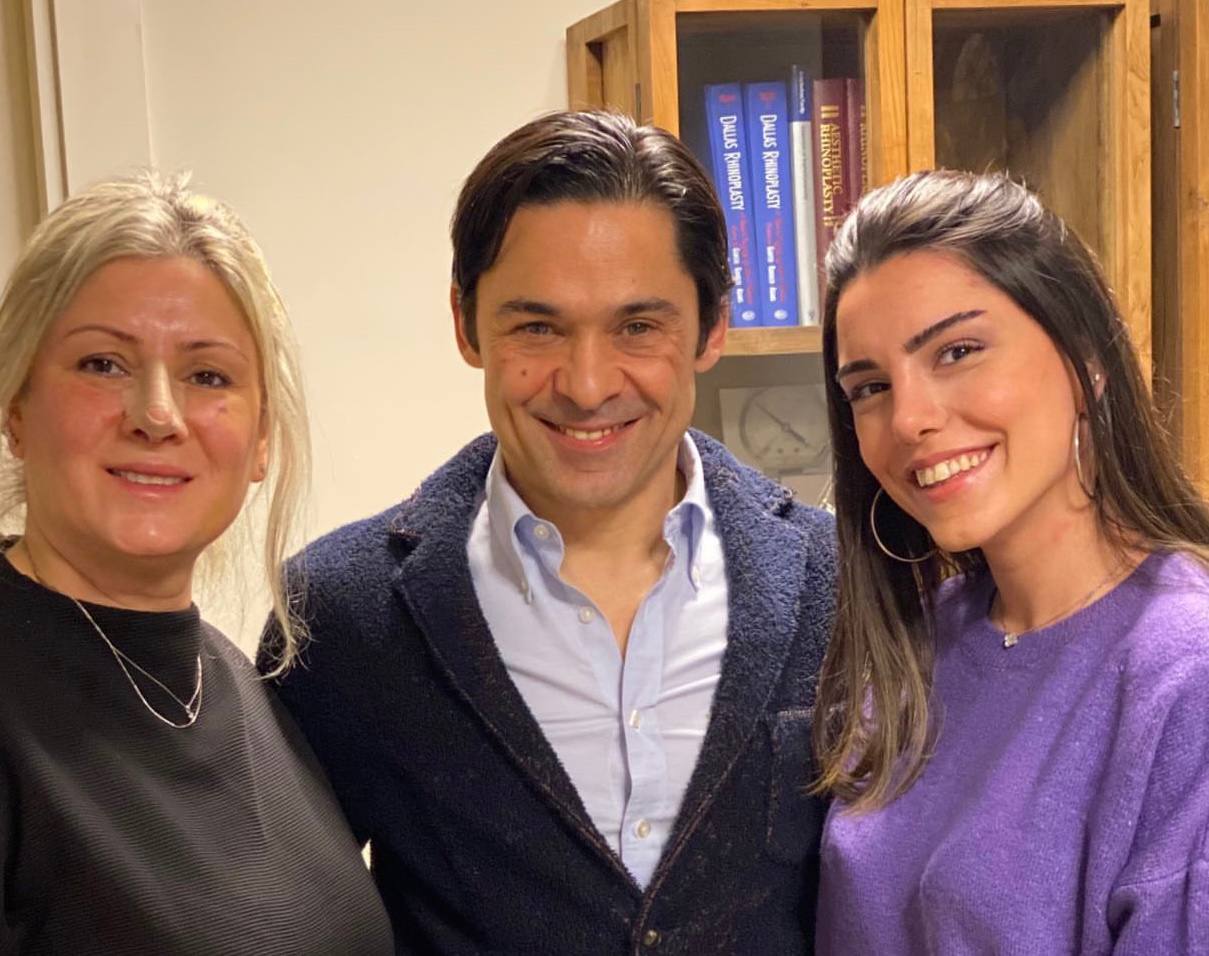
What is Septorhinoplasty?
Septorhinoplasty is a complex surgical intervention aimed at improving both the aesthetic and functional aspects of the nasal structure. This procedure consists of two main components:
Rhinoplasty:
- Improves the external shape of the nose aesthetically.
- Involves reshaping the cartilage and bones.
- Changes in appearance can enhance facial symmetry.
Septoplasty:
- Makes breathing easier.
- Corrects curvatures in the nasal septum.
- Resolves breathing problems such as a deviated septum.
The surgical process is performed under general anesthesia, and the duration of the procedure typically ranges from one to three hours. The surgeon carefully works on the cartilage and bones to achieve both aesthetic and functional improvements. The precise interventions during this procedure enable the patient to achieve better breathing and satisfying aesthetic results.
The recovery process varies from person to person but generally takes a few weeks. Complete recovery may take up to a year. Patients should be careful during the recovery process and follow the doctor’s recommendations to achieve the best outcome.
When performed by a specialist surgeon, this treatment can effectively resolve both aesthetic and functional issues. Patients should have a detailed consultation with their surgeon about the expected outcomes and possible risks before and after the surgery. Understanding the necessity of the surgery, how it is performed, and what to pay attention to afterward is crucial for patients during this process.
6 Reasons to Get Septorhinoplasty in Istanbul



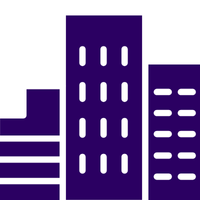
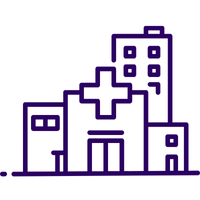

Post-OP
Care
Transform into the New You!
What are the Advantages of Septorhinoplasty?
Septorhinoplasty is a preferred surgical method to improve both the functions and aesthetic appearance of the nose. This operation allows for structural changes that directly improve breathing. As a result, patients experience noticeable relief in their daily lives.
- Better Breathing: The operation makes breathing easier, which increases exercise capacity. It also improves sleep quality and reduces sinus problems.
- Enhanced Appearance: Aesthetic interventions make patients feel better about themselves, boosting self-esteem. Unwanted nose shapes and traumatic deformities can be corrected.
- Single Surgery: Functional and aesthetic problems are resolved with a single operation. This provides both structural and cosmetic improvements simultaneously.
- Single Recovery Period: This dual-function intervention requires only one recovery period. This not only saves time but also makes the recovery process easier.
- Cost-Effective: Instead of two separate procedures, a single operation provides both structural and aesthetic improvements, reducing costs.
- Increased Self-Confidence and Self-Esteem: The aesthetic appearance achieved after the operation makes patients feel better about themselves.
- Improved Quality of Life: Improved overall breathing function allows patients to be more active and feel more comfortable in social interactions.
These advantages make septorhinoplasty an attractive option for individuals seeking to improve nasal functions and aesthetic appearance. Each advantage contributes to the patient’s physical and psychological recovery process, allowing for a healthier and happier life.
What are the Alternatives to Septorhinoplasty?
If a person’s nasal obstruction is due to a deviated septum, it can be treated with a procedure called septoplasty. In this case, the septum is corrected, but the external appearance of the nose does not change. A different situation is when the nasal bones are crooked or damaged. In such a blockage, septoplasty may be insufficient, and rhinoplasty may be required. Rhinoplasty is used to improve both breathing functions and make aesthetic adjustments. Here are some conditions and the surgical methods that can be applied to them:
For those with only septal deviation:
- Septoplasty
Conditions requiring both aesthetic and functional correction:
- Rhinoplasty
- Septorhinoplasty
Turbinoplasty: Function and Implementation Reasons
Turbinoplasty is performed to alleviate nasal obstruction and improve airflow. In individuals with chronic nasal congestion, this condition often occurs due to enlarged turbinates. The main reasons for turbinoplasty are as follows:
- Chronic allergies, irritation, or infections can cause the turbinates to enlarge, making breathing difficult. Enlarged turbinates narrow the nasal cavity, obstructing airflow.
- Turbinoplasty is performed to reduce these enlarged turbinates, widening the airway and making nasal breathing easier.
The process of performing turbinoplasty includes the following steps:
- First, an ENT specialist evaluates the patient’s condition. Chronic congestion and the factors causing this congestion are identified.
- The surgical procedure is performed under general anesthesia. Excess tissue around the turbinate bones is removed, reducing the turbinates.
- The recovery process after surgery is generally quick. Patients can return to normal activities shortly after the operation.
Turbinoplasty is usually recommended in the following situations:
- Individuals experiencing chronic nasal congestion
- Those with turbinates enlarged due to allergic reactions and constant irritation
- Those experiencing chronic turbinate enlargement due to infections
This procedure can often be combined with other nasal surgeries. For example, performing it with septoplasty or rhinoplasty provides both aesthetic and functional improvements.
The success rate of turbinoplasty is high. However, despite the possibility of tissue regrowth, most patients are satisfied with the results of the operation. This surgical method offers an effective solution for individuals suffering from chronic nasal congestion and can significantly improve their quality of life.
What Techniques are Used in Turbinoplasty?
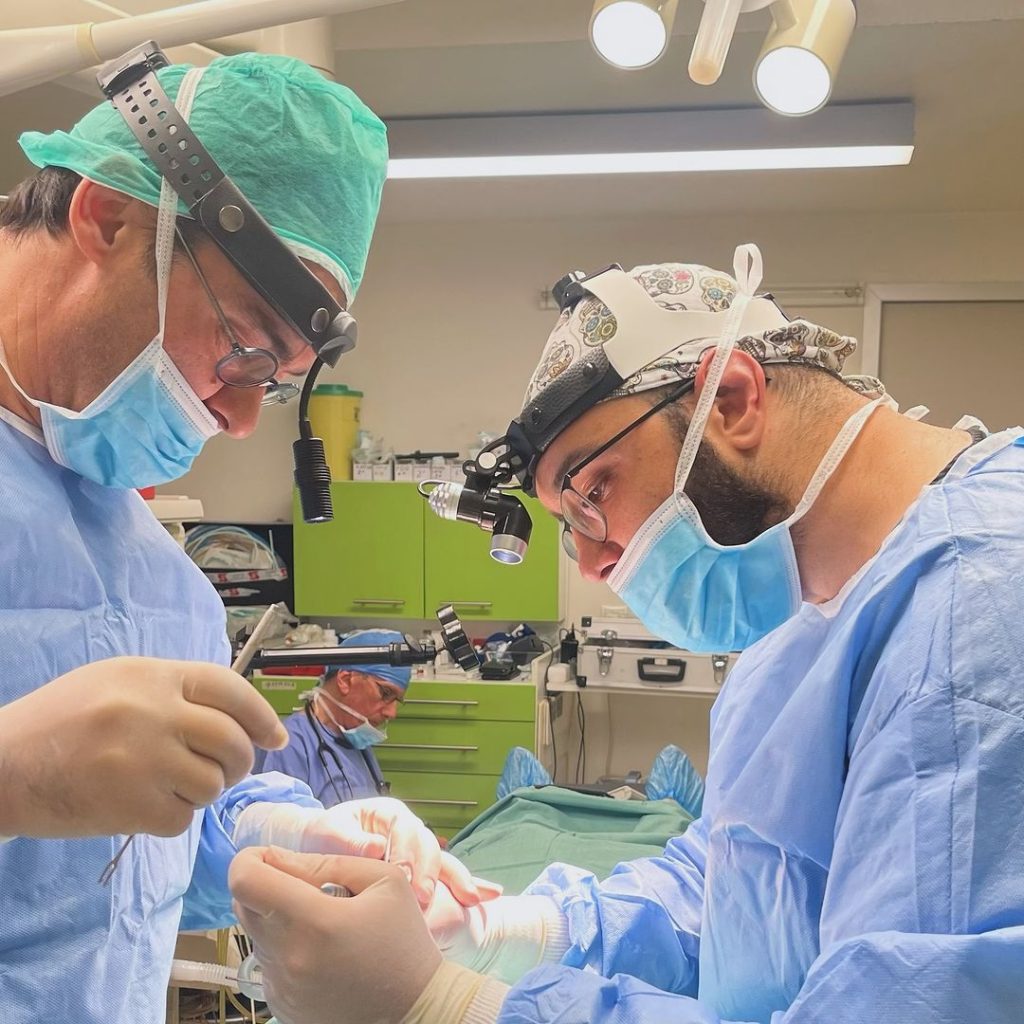
Turbinoplasty is performed using several different techniques. Each technique offers specific advantages and is chosen based on the surgeon’s preference. The procedure can be performed under general or local anesthesia, either in a hospital or clinic. The recovery process usually involves mild discomfort and lasts a few days. Detailed instructions provided by the healthcare professional should be followed after surgery.
Cauterization:
- A heated probe is inserted into the nose, performing the procedure of sealing blood vessels.
- This method reduces blood flow, causing the tissues to shrink.
Radiofrequency Turbinoplasty:
- A long and thin probe delivers heat energy to the inflamed turbinates.
- Heat energy is used to reduce the turbinate.
Coblation:
- Heat energy is used to reduce the turbinates.
- This method operates at a lower temperature to avoid damaging surrounding tissues.
Microdebrider Submucosal Resection:
- The surgeon creates a small opening in the turbinate to remove tissue.
- The outer lining allows the tissues to shrink during the healing process.
Partial Resection:
- A small part of the turbinate is removed.
- This method removes both hard and soft tissue.
Postoperative crusting can result from nasal discharge. Using saline nasal spray or moisturizer is recommended during the recovery process.
How is the Septorhinoplasty Procedure Conducted?
Septorhinoplasty is a surgical method that corrects curvatures in the septum. Different techniques can be applied based on the patient’s general condition and specific problems in the septum. The surgical process aims to improve the internal structure of the nose and optimize its aesthetic appearance.
The surgeon makes an incision inside the nose to perform the operation. This incision provides access to the septum for removing or reshaping cartilage and bones. The patient feels no pain during the procedure as they are under sedation.
The steps considered in the surgical procedure are as follows:
- Gently lifting the cartilage and bone structures.
- Removing or reshaping the curved parts.
Other structures that may affect nasal function are also addressed during this process. In this process;
- Nasal turbinates that make breathing difficult are corrected.
- Bone structures are positioned appropriately to achieve an aesthetic appearance.
Postoperative procedures include:
- Carefully closing the incision site.
- Using gauze to control bleeding.
- Placing splints or plastic plates to support proper healing of the septum.
Splints or tampons are removed by the surgeon at the next appointment. Patients can usually return home on the same day. The recovery process varies based on individual differences.
What are the Risks and Side Effects During and After Septorhinoplasty?
The septorhinoplasty procedure can involve a range of risks and side effects. Surgical procedures are generally subject to certain complications, and septorhinoplasty is no exception. Being aware of these risks helps patients and healthcare professionals take precautions.
General complications of any surgery:
- Bleeding
- Infection at the surgical site
- Allergic reactions to equipment, materials, or medications
- Venous thromboembolism (VTE)
- Chest infection
Complications specific to this surgery:
- Formation of scar tissue deep within the nose
- Adhesions that can obstruct airflow
- Bleeding caused by infection
- Formation of unsightly scars
- Accumulation of blood or abscess development between the septum layers
- Damage to the nerves supplying the skin on the tip of the nose
- Nasal congestion
- Perforation of the septum
- Toxic shock syndrome, an infection of your blood circulation
- Cosmetic issues
- Problems at the donor site
- Graft rejection
- Reduction in the sense of smell
- Tearing eyes
Results of this procedure:
- Pain
- Redness
- Bruising and swelling around the nose and eyes
Informing the surgeon of all medical conditions before the operation can reduce the risk of complications. Especially rheumatological conditions like lupus or osteoarthritis, smoking, and certain medications can affect wound healing. While most complications are treatable, some may require additional surgical intervention. Patients may notice that their symptoms do not improve after the surgery, and additional operations may be necessary to alleviate these symptoms. Therefore, it is important to consider all these factors before deciding on septorhinoplasty.
What to Expect After Septorhinoplasty?
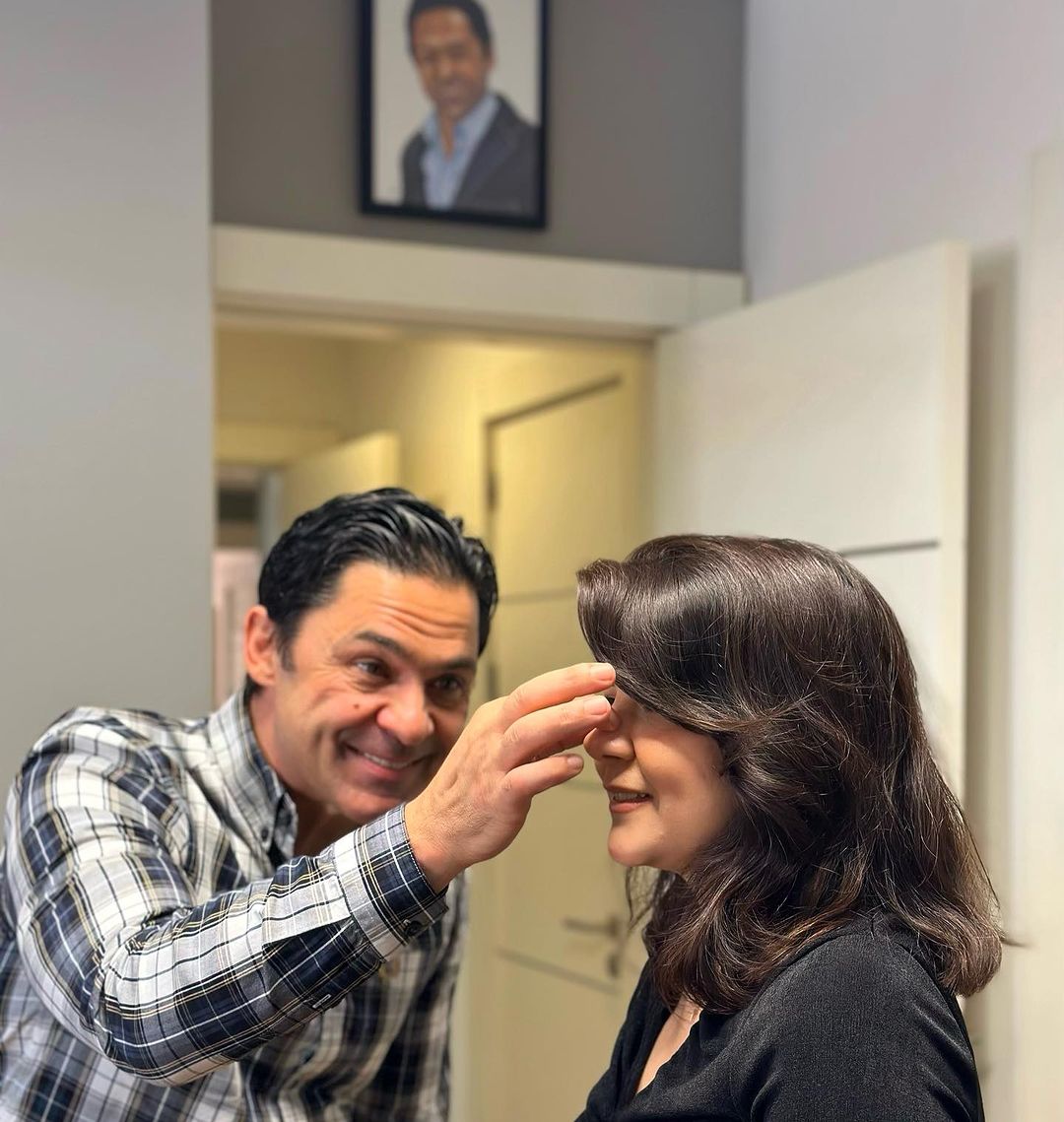
The recovery period after septorhinoplasty spans a few weeks and must be carefully managed. Certain precautions recommended by the surgeon during the postoperative period are crucial. First, it is recommended to keep the head elevated while sleeping to minimize bleeding and reduce swelling. Patients are also advised not to blow their noses, as this can put pressure on the delicate tissues post-surgery.
- Keeping the head elevated while sleeping
- Avoiding blowing the nose
- Not wearing clothes that go over the head
- Avoiding intense cardiovascular activities
It is important to remember that the type of clothing worn during this period is significant; avoiding clothes that pull over the head can contribute to the healing process. It is also recommended to avoid activities like running, as intense cardiovascular activities can place unnecessary strain on the newly shaped nasal tissues and delay healing.
It generally takes three to six months for the nose to stabilize. During this period, noticeable improvements in breathing and nose shape are expected. Patients may continue to see changes in their noses for up to a year after surgery.
How to Prepare for Septorhinoplasty?
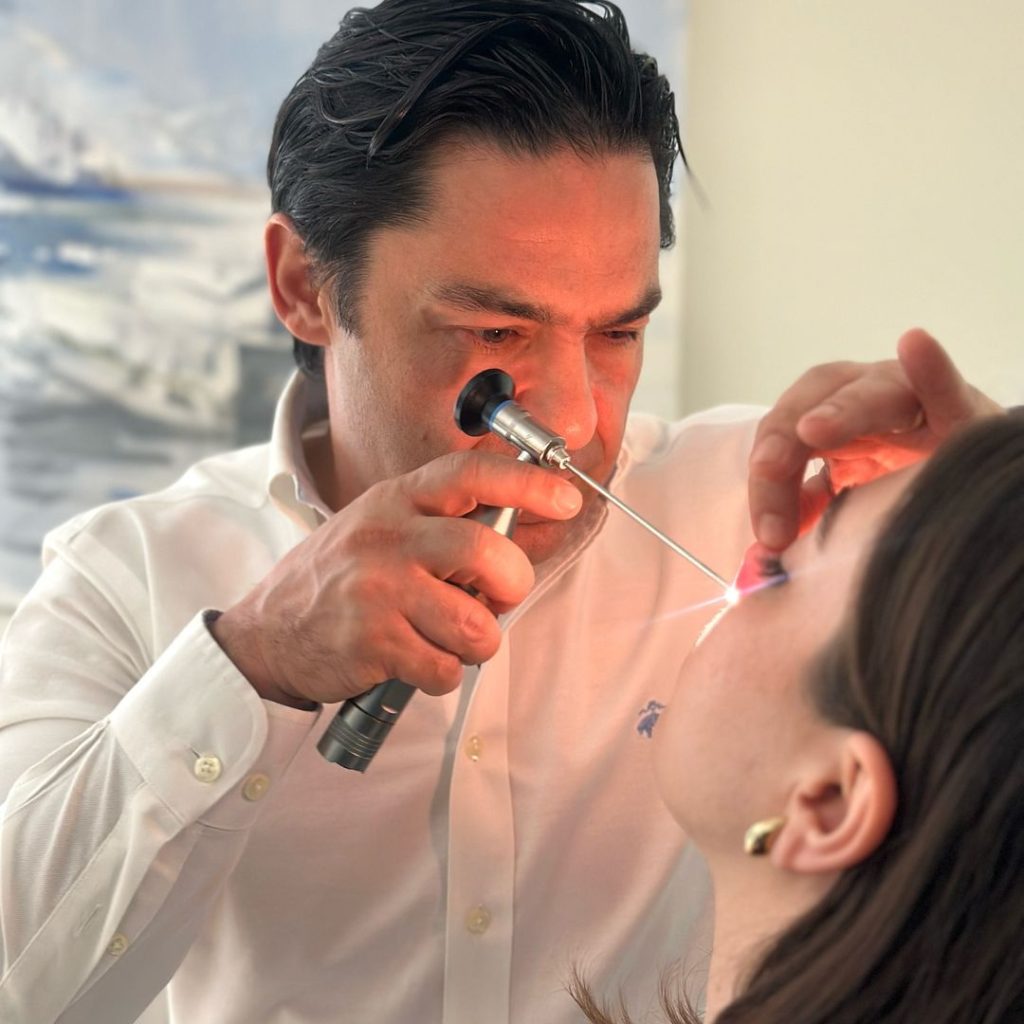
The preparation process for septorhinoplasty includes important steps that directly affect the success of the surgery. First, you will meet with your surgeon to thoroughly review your medical history. During this consultation, your expectations from the surgery should be clearly expressed. The surgeon will inform you about what to pay attention to before and after the operation. Once your surgical plan is determined, certain precautions will be recommended for you to take. These precautions include:
- Quitting smoking: Smoking slows the healing process and increases the risk of complications.
- Avoiding the use of certain medications: Some medications can increase your risk of bleeding.
Your surgeon will take photos of your nose and make detailed measurements before the surgery. This plays a critical role in planning the surgery and evaluating the expected results. Additionally, you will be informed about which medications can be safely used. Precautions such as quitting smoking and avoiding certain medications help ensure a faster and smoother recovery process after surgery. These preparations are the steps to take towards septorhinoplasty and are aimed at increasing your satisfaction with the surgery and minimizing risks. Each step should be carefully planned and implemented.
How Much Does a Septorhinoplasty in Turkey in 2025 ?
The cost of a Septorhinoplasty in Istanbul, Turkey, typically ranges between €5,000 and €7,000. The price can vary depending on several factors, such as the surgeon's experience, the complexity of the procedure, the clinic's reputation, and additional services included in the package.
| Average Septorhinoplasty Cost (in Euros) in 2025 | |
| United Kingdom | €16,600 – €19,000 |
| United States | €14,200 – €23,400 |
| Canada | €16,000 – €19,000 |
| Australia | €23,800 – €37,800 |
| South Korea | €9,400 – €17,200 |
| Ireland | €13,000 – €15,000 |
| Germany | €11,000 – €13,000 |
| Netherlands | €11,000 – €13,000 |
| France | €11,000 – €13,000 |
| Turkey | €5,000– €7,000 |
Frequently Asked Questions
The Social Security Institution may cover the cost of septorhinoplasty surgery. However, for this surgery to be covered by the SGK, it must be medically necessary for the patient. Septorhinoplasty is evaluated within the scope of SGK for patients experiencing breathing difficulties. If the surgery is performed for aesthetic purposes, SGK does not cover the expenses. Patients can have this procedure done in public hospitals or private hospitals contracted with SGK.
Septorhinoplasty is a technically challenging surgical procedure. Since this operation involves both aesthetic and functional corrections, it requires detailed expertise. Therefore, it can be successfully performed by an experienced surgeon. Additionally, the experience of the surgeon can significantly reduce the difficulty level of the operation. Patient satisfaction may vary depending on the surgeon’s skills and the techniques used during the operation. As a result, septorhinoplasty requires a comprehensive evaluation and a careful surgical approach.
Septoplasty surgery does not aim to change the shape of the nose. It primarily corrects the internal airways of the nose, improving respiratory function. This procedure is a functional intervention to facilitate breathing rather than an aesthetic change. Therefore, septoplasty does not alter the external appearance of the nose. However, for those desiring an aesthetic correction, septorhinoplasty is recommended because this procedure provides both functional and aesthetic improvements.
The duration of septorhinoplasty usually ranges from one to two hours. However, this process may be extended or shortened depending on the patient’s specific condition, the number of procedures performed during surgery, and the surgeon’s experience. Therefore, the duration of the operation may vary for each patient. Additional procedures planned according to the patient’s needs are an important factor affecting the operation’s duration. The surgeon’s experience is also another factor that determines the length of this process.
Septorhinoplasty surgery prices vary depending on several factors. The complexity of the operation significantly affects the cost. Additionally, the surgeon’s experience and the quality of the hospital also play a role in pricing. Geographical location can also cause price differences. Preoperative examinations and tests may also incur additional costs. Insurance coverage depends on the reason for the surgery. Aesthetic surgeries are usually not covered by insurance. However, surgeries performed to solve functional problems are often covered by insurance. The best way to get detailed information is to contact your insurance provider.
Breathing problems generally improve significantly after septorhinoplasty surgery. The surgery opens the airways inside the nose, making it easier for the patient to breathe. During this process, issues like nasal curvature and obstruction are resolved. However, the recovery process can vary from person to person. It may take a few months for the full results to become apparent. Therefore, it is very important for patients to strictly follow the doctor’s recommendations.
In septorhinoplasty surgery, nose aesthetics and septum correction are performed together. The first step is to correct the septal deviation. Here, the curved cartilage and bone structures are either removed or reshaped. Following this, the nose aesthetics procedure is performed, giving the nose the desired appearance. This process is meticulously planned to achieve both aesthetic and functional improvements. Both procedures are combined to enhance the patient’s appearance and nasal functions.
Septorhinoplasty surgery is usually performed by ENT (Ear, Nose, and Throat) and Head and Neck Surgery specialists. These experts are the most knowledgeable doctors about the structures and functions of the face and head regions. Therefore, they are the most qualified individuals for such surgical interventions. Additionally, they have the necessary equipment to meet both the aesthetic and functional needs of patients while performing these surgeries. Consequently, these specialists perform septorhinoplasty surgery to achieve the best results.
Septoplasty surgery is an operation performed without changing the shape of the nose and without aesthetic intervention. However, septoplasty surgery can be combined with aesthetic nose surgery, in which case the nose is improved both functionally and aesthetically. In this type of combined surgery, the internal structures of the nose are preserved while making aesthetic changes. Therefore, septoplasty surgery itself is not aesthetic, but it can be performed with rhinoplasty.
In septoplasty surgery, the procedure is completed with self-dissolving stitches. The stitches are placed inside the nose and do not leave any external scars. Additionally, there are no stitches that need to be removed after the surgery, as all stitches dissolve on their own over time. Therefore, patients heal without any visible stitches on the outside of the nose.
A tampon is used in septoplasty surgery. These tampons are necessary to reduce the risk of bleeding during the postoperative period. They are also used to stabilize the septum. Intranasal tampons support the healing process after the surgical procedure and minimize the risk of complications. Moreover, the placement and removal of tampons should be done carefully to increase patient comfort. Therefore, the use of tampons is a common practice in septoplasty procedures.
Unsuccessful septoplasty can be identified by the continuation of nasal congestion, changes in the shape of the nose, or alterations in taste and smell senses. Additionally, permanent facial pain, voice changes, and visual defects can also be signs of failure. However, revision surgery is possible in this situation. It is generally necessary to wait 6 months to 1 year to determine if revision surgery is required. This period can vary depending on the patient’s healing process and condition.
Voice changes after septoplasty are usually minimal. Most patients do not notice significant differences in their voices after the surgery. If there is a significant deviation in the nasal septum, correcting the nasal passage can improve voice resonance and slightly enhance voice quality. However, if the septum deviation is minor, there will be no noticeable change in voice tone. To prevent unwanted voice changes, proper diagnosis and surgical techniques are essential. Incorrect diagnosis and technical errors can negatively affect the voice tone. Therefore, selecting an experienced surgeon is of critical importance.
The main difference between open and closed septoplasty is the method of access to the septum. In closed septoplasty, incisions are made only inside the nostrils, which prevents any external scarring. This method is generally less invasive and has a shorter recovery time. In open septoplasty, an incision is made in the columella (the tissue between the nostrils). This technique is preferred for particularly complex cases as it provides the surgeon with greater access to the septum. Both methods are used to improve nasal airflow, but the chosen method depends on the severity and location of the septal deviation.
One of the Best Clinic Team for Septorhinoplasty in Turkey
Dr. Alev Camcıoğlu is considered to be one of the best Septorhinoplasty surgeon in Turkey. You can check Septorhinoplasty reviews here.
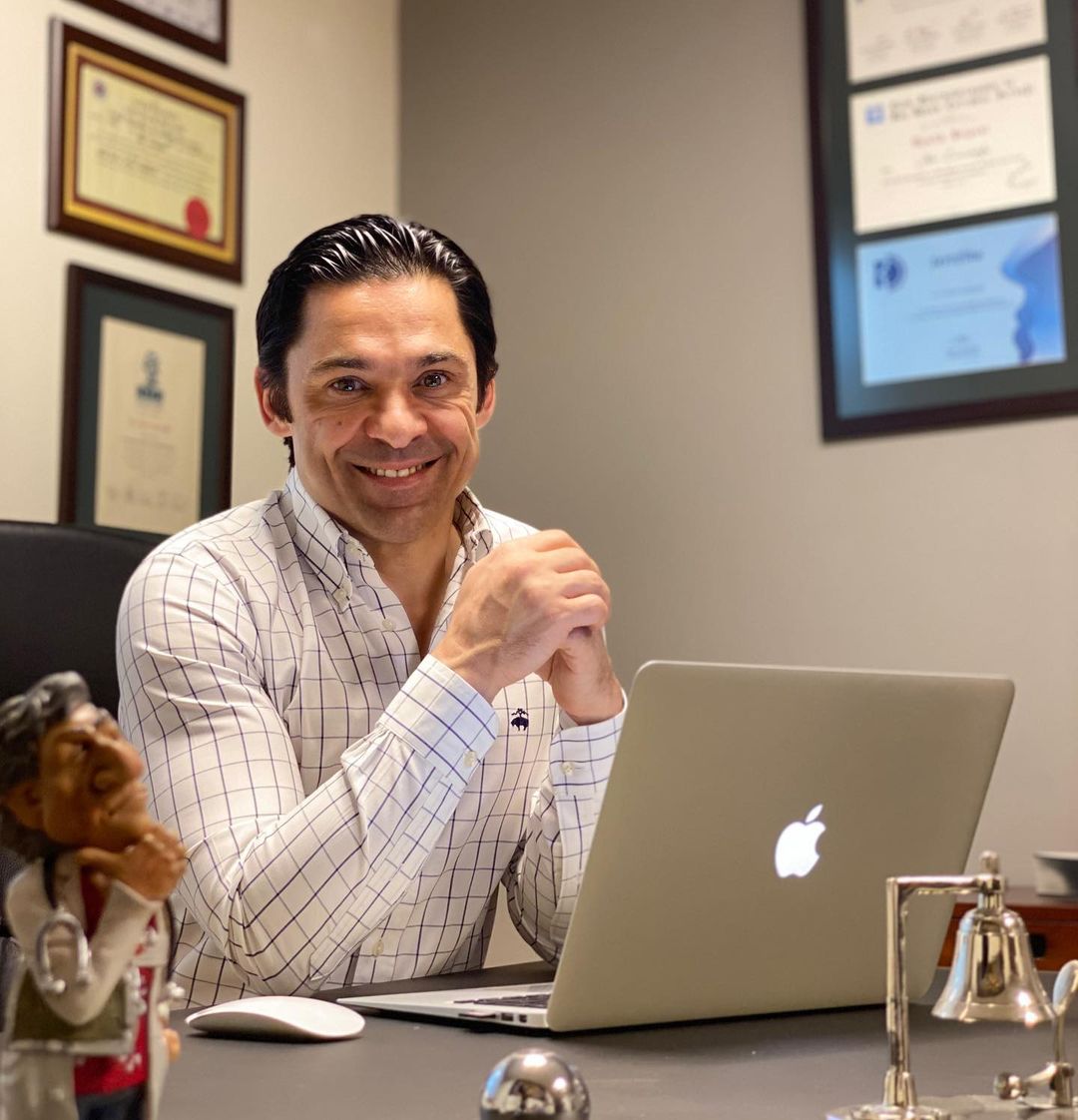
Op. Dr. Alev Camcıoğlu
Rhinoplasty Surgeon
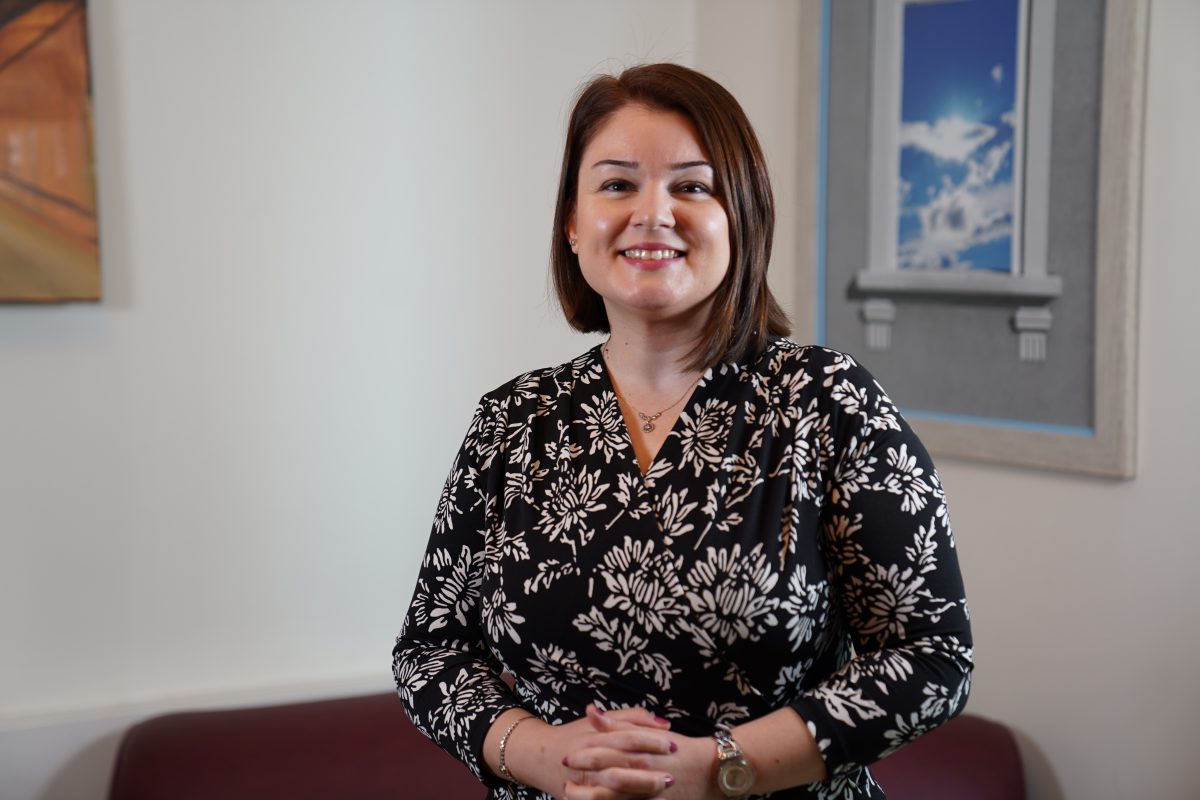
Aylin Uyuşmak
Clinical Coordinator
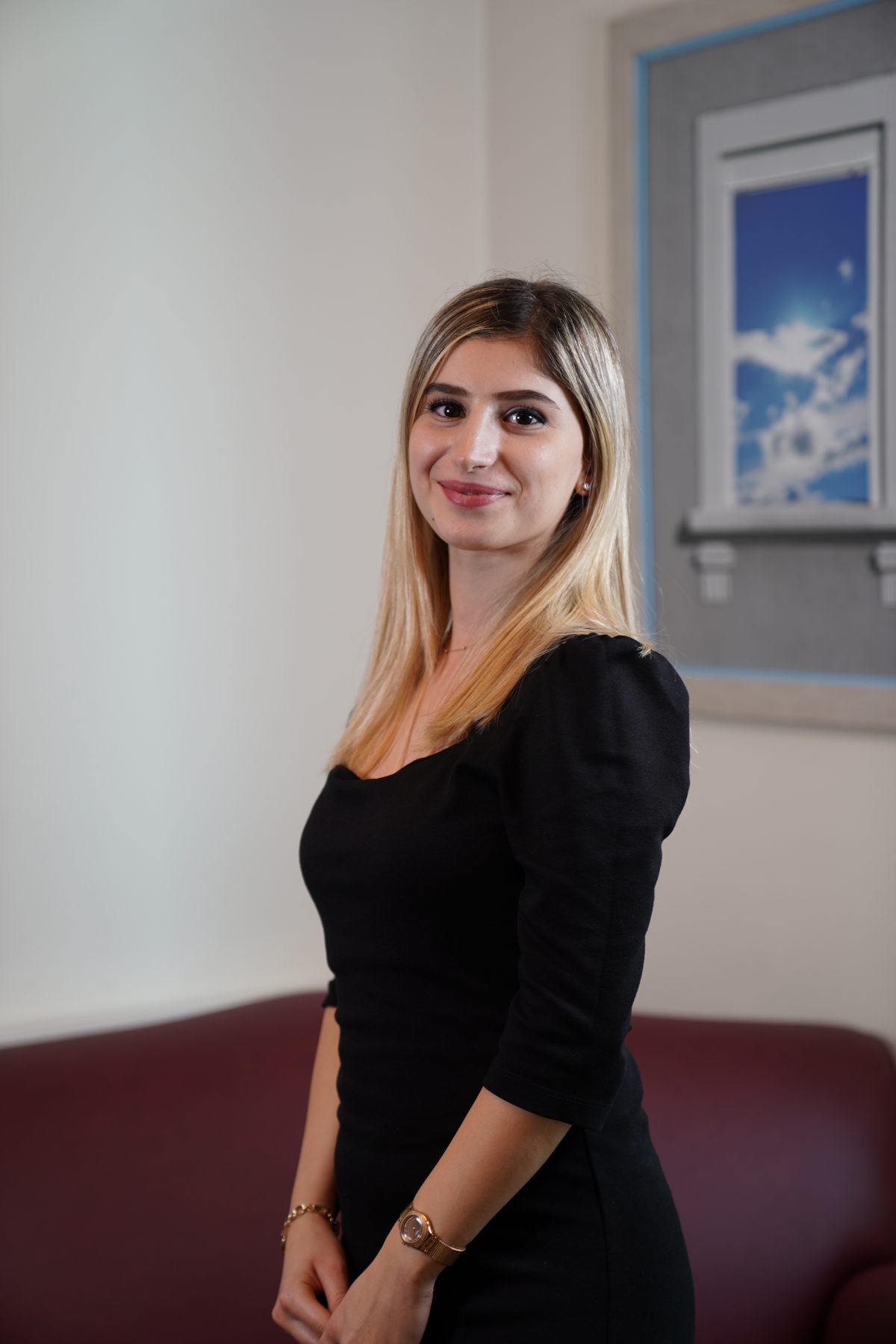
Serra Sevgili
Clinical Assistant
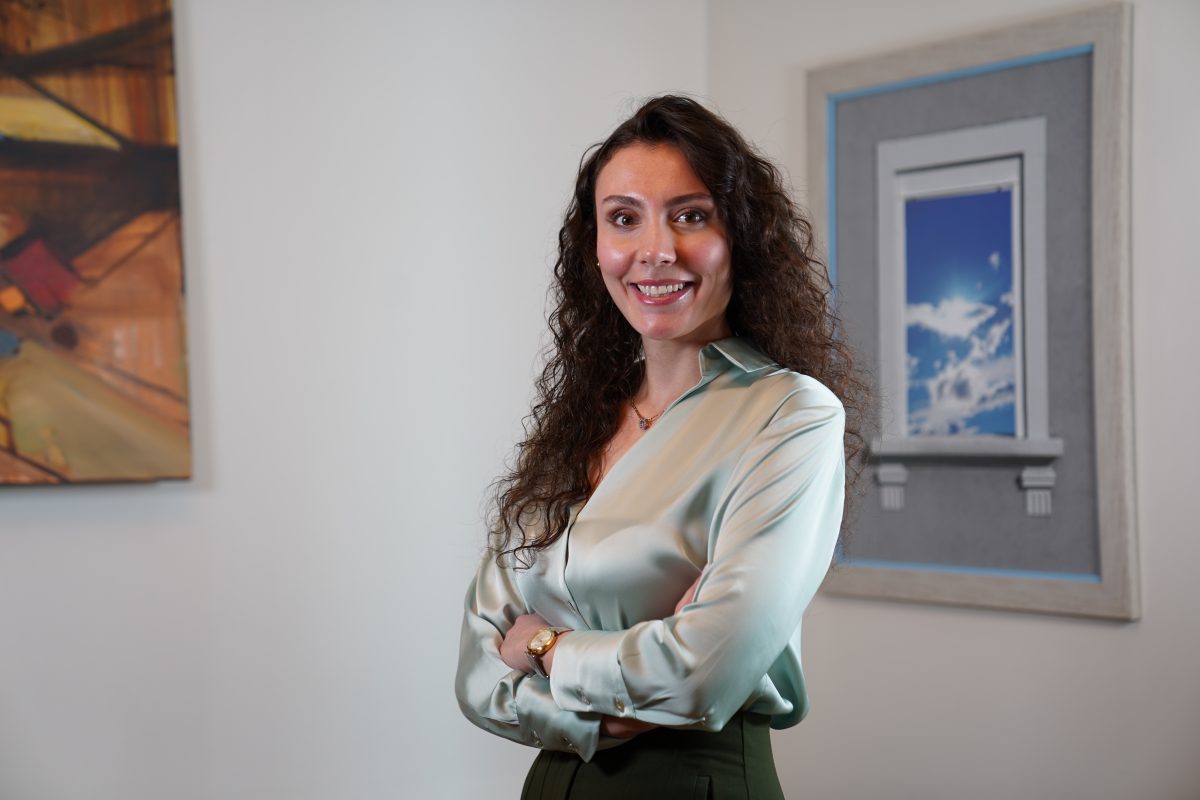
Sema Yapıcı
Operating Room Nurse
